Life Cycle of a Sourdough Starter Part I

This post is the all wordy stuff I have found on sourdough starter and it’s suppose to sit alongside my step-by-step photo post of the Life Cycle of a Sourdough Starter Part II, go ahead and check it out.
I use the term, starter/levain/leaven/motherdough interchangeably. In the Advance Bread & Pastry book it explains the term for levain/leaven is the final feed you’ve made to your starter before you incorporate it into the dough but this is a bit confusing for me since I keep on feeding and using that for baking most of the time and essentially I’m always using one feed as my last feed.
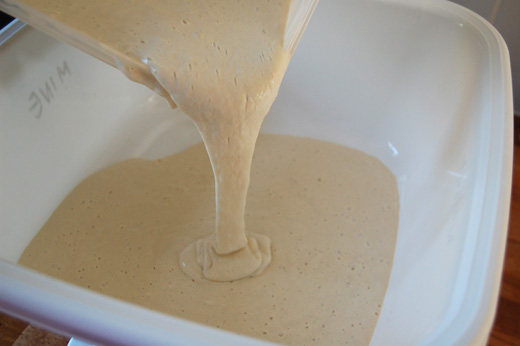
Out of my text books the Advance Bread & Pastry book has the most detailed information but not necessarily very well explained. The How Baking Works book which did so well in my Rye Flour post is lacking and my bible Harold McGee has a small entry on sourdough. On recommendation from Gregoire I have Technology of Breadmaking on my wish list, it’s waiting for the purchase button to be clicked…soon…
The best and most intense information that I know of exist in a post by Debra Wink on the Fresh Loaf forum, it was passed on to me by Daisy on the forum and I’ve passed on this post to other bakers in the meantime but I’m quite sure they’ve looked at it decided it needed some head space to read it and left it for another day.
The very first time I read Debra’s post many months ago I struggle to make sense of it, I manage to absorb about 25% of it. But then through a learning curve on sugars for my ice-cream post in January, the more recent posts on doughs and flours, my investigations with flour mills, have all contributed to my now understanding it. The details of the homofermentative and Heterofermentative pathways when talking about ‘6-carbon sugars’ or ‘5-carbon molecule is split unequally into 3- and 2-carbon units’…well that still makes my brain spin a little bit too fast for my liking…but I really don’t have to understand the ins and outs of carbon units.
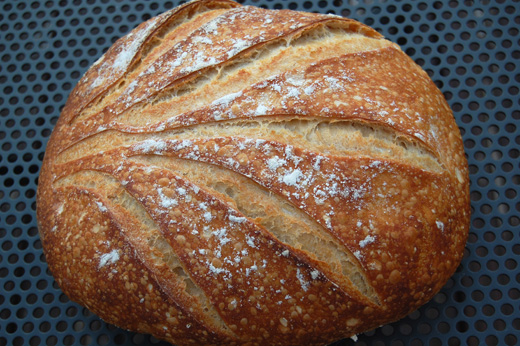
Debra’s Post
Metabolic pathways is essentially what the post is about. I did a wiki on metabolic pathways and interestingly found myself in this sequence: Metabolic Pathways -> Substrate -> Molecule -> Atoms -> Unit of matter -> Atoms, Particles -> mass -> matter. These words are familiar to me but they belong to a different world, not to someone like me who doesn’t own a scientific brain, I just accept they’re there. After molecule I don’t have to concern my pretty little brain about it. Believe me, electricity still astonishes me really, I know how it happens but still…
It takes time for things to sink in. The other challenge has been concentrating long enough with the constant distractions of family needs. I would happily lock myself away for days…only occasionally to dip in and out of twitter and for refreshments.
I say to anyone who seriously wants to know their starter better and how to control its acidity or its leavening ability to read Debra’s post. There will be nuggets of gold you’ll take in, also importantly read her answers which have so much detail too. I will refer to her work as I go.
What’s It All About in a Nutshell?
Debra shows in detail the pathways microbes take, “…microbes need energy to perform the tasks that enable them to live, grow and multiply.” The pathways described are the ones taken using the sugars available and at the other end of the journey transforming them into lactic acid, acetic acid, carbon dioxide gas, alcohol.
I explained very briefly last night to Bikerboy who was exhausted to see if I could explain to someone a) not interested in sourdough making b) not interested in biochemistry…and I managed it, see my To Put It Simply.. I’ve also added lots of detail in the post hoping it’s of interest, I think it partners well with my step-by-step post on the Life Cycle of the Sourdough Starter Part II.
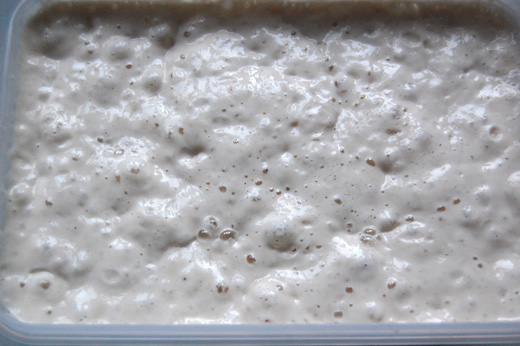
To Put It Simply…
I will put it into the most basic way I know, what all this Sourdough lark is about. I wish the text books had done the same and saved me the trouble of having to read really big words.
In your starter there is wild yeast and bacteria. There is a balancing act between bacteria and yeast in the starter and obviously in the resulting sourdough. To put it simply the more yeast in your starter the more power of rising the dough will have, but the downside is lack of sufficient acidity you may want in your loaf. The more you let your bacteria grow the yeast doesn’t survive and therefore you lose rising power for the dough but you’ll have more of a pronounce “sour” tasting bread. The more frequently you refresh your starter the more you aid the yeast cells by introducing oxygen and it helps keeping the environment less acidic. Yeast can manage without oxygen but are happier using it if it’s available. However, the longer you leave your starter without feeding it the more chance bacteria has to flourish and add a ‘tangy’ note to your loaf. The temperature you keep your starter at decides which bacteria survive which doesn’t. That’s it in a nutshell.
Debra points out at the beginning of her post, this is where the Artisan’s baker skill comes in, to balance the two for the result s/he is trying to achieve. Here lies your talent.
Her whole post is trying to inform us bakers, one of the most important things for us to get right is a healthy starter and to maintain a healthy starter with consistency, thus enabling us to produce a bread of choice rather than a bread by chance.
Controlling our starter is the beginning of controlling our sourdough before moving on to decide other factors such as recipes and retarding methods.

Let’s Start at the Beginning – What’s in a Starter?
Most of the microbes in a starter come from the flour, where according to Advance Bread & Pastry book says, ‘…one gram contains about 13,000 cells of wild yeast and approx 320 cells of lactic bacteria’. The rest of the microbes will come from the air, water, and even yourself. The main microorganisms are wild yeast and bacteria. As with all microbs which survive and thrive will depend on the condition of a few things like hydration, ingredients and temperature and according to Debra the routine and consistency of your feeds.
Sourdough’s Wild Yeast
Sourdough has wild yeast. The wild yeast in a starter comes mainly from the Saccharomyces cerevisiae family, just like the commercial yeast but they differ genetically. And if you love your meaty words some other species of wild yeast are Saccharomyces exiguus, Candida tropicalis and Hansenula anomala…I bet you won’t be able to roll those out of your tongue very fast. Not surprisingly these wild yeasts can cope better with an acidic environment than commercial yeast can.

The Importance of Bacteria
I’m sure by now you’ll know all about lactic acid bacteria present in sourdough, of which if you look it up Lactic Acid Bacteira (LAB), on wiki there are different species and strains but they all fall under the same job description, while they’re feeding on the sugars available to them they produce lactic acid. The different ‘pathways’ the different strains take result in differences, like the production of another acid; acetic.
They’re also present in yeast doughs introduced by the flour and yeast but from interpreting what Debra said the greater number of them in sourdough comes from the thriving environment they have in the starter. Your starter is a swimming pool of happy bacteria breeding until their hearts’ content under the right conditions, which translate to the strong flavour sourdough has.
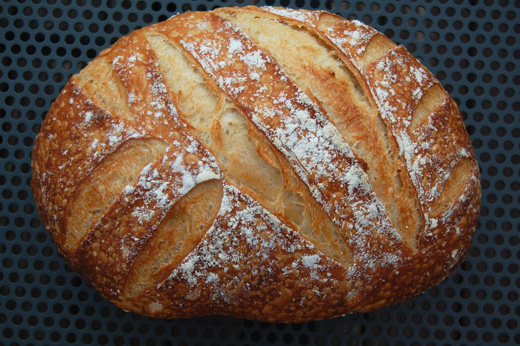
Remember I said the balancing act between bacteria and yeast?
McGee states that bacteria thrive in warm temperature 30-35C (86-96F) but yeast in acid environment grow better in a cooler temperature of 20-25C (68-78F). Bacteria growing much more rapidly than yeast always outnumbers them.
Debra points out there’s a misconception that if you want to acidify your starter you keep it in the fridge. She says this is not true, as lowering the temperature to that extent lowers their multiplication. Makes sense to all of us about hygine and bacteria, warm temperatures and the dangers of bacteria flourishing. And McGee just pointed out the ideal temperature for bacteria growth is 30-35C.
If like me you leave your starter on the kitchen worktop and have experienced a hot summer, you would’ve noticed how quickly the starter bubbled up and how quickly it went past its height of activity and developed a sour smell or as I always refer to it as the ‘wallpaper paste’ smell. When you compare that to the winter months in my unheated kitchen during extremely cold days it can take 24hrs before I see any activity going, a drastic change from the few hours in a hot summer’s day.
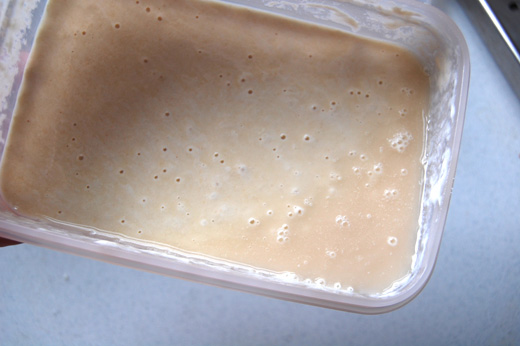
Acidifying Your Starter
So where’s this misconception come from? As I understand, it comes from the fact that acetic acid in the starter is increased at lower temperatures.
In your starter as well as lactic acid, there’s acetic acid and the talk was, if you want to make your starter more acidic you should keep the temperature low because it encourages the growth of acetic acids.
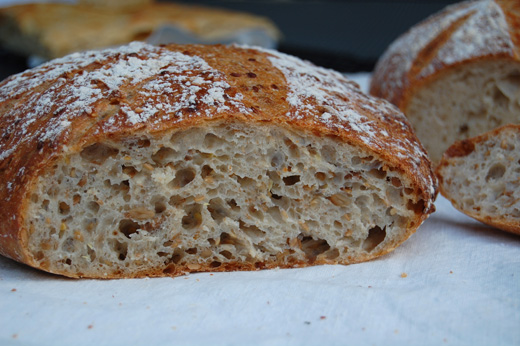
Acetic Acid
Some lactic acid bacteria (LAB) take a Homofermentative pathway which means they end up producing all lactic acid, other LAB take a Heterofermentative pathway which means ‘different’ or mixed end products, they can produce lactic acid, ‘...but they also produce carbon dioxide gas, alcohol or acetic acid as well‘.
According to Debra she explains that although the low temperatures does increase the growth of acetic acid, the overall growth rate is lower at colder temperatures, ‘…higher temperatures mean acids accumulate faster, with a higher ratio of lactic to acetic. Lower temperatures produce acids slower, but the percentage of acetic increases’.
Although she doesn’t mention in the main post Debra elaborates more fully in an answer to a question why there’s an increase of acetic acid produced, ‘At lower hydrations and temperatures (lower activity), more acetic acid is produced, but not because of temperature per se. Acetic acid production is influenced indirectly by temperature, in that it affects the kinds of sugars available.’
‘The fructose that drives acetic acid production, is liberated from fructose-containing substances in flour, largely through the enzyme activity of yeast. And, because lower temperatures are more suited to yeast growth than higher, more fructose is made available to the bacteria at lower temperatures.’
Debra has a long explanation in one of her answers on wholewheat starters and why they happen faster and are more acidic, scroll down to the answer dated January 28, 2009.
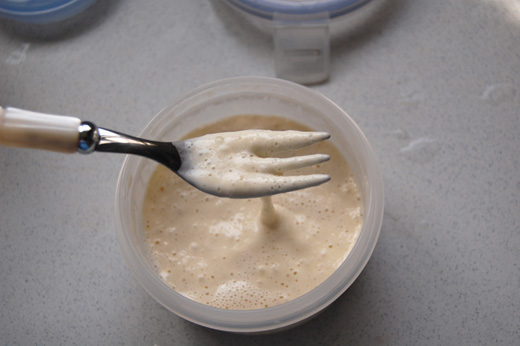
Homofermentative Pathways, Heterofermentative Pathways and…Facultative Heterofermenters
…I mention homofermentative pathways above which LAB using this pathway will produce all lactic acid, LAB using Heterofermentative pathways can produce lactic acid, carbon dioxide gas, alcohol or acetic acid…but…there’s also LAB that are facultatively heterofermentive. ‘These are lactobacilli that are not restricted to one pathway or the other, but can use both. Facultative heterofermenters switch back and forth between the homo- and heterofermentative pathways depending upon which sugars are available’.
Clever little things aren’t they? I think that’s called the survival of the fittest…changing according to what’s available.

Liquid Starters, Stiff Starters, Flour and Temperatures
McGee mentions both yeast and bacteria grow fastest in a liquid starters and in a stiff starters they grow slower. This matches with my experience. In liquid starters microbes have an easier time accessing nutrients, and stiff starters require less attention.
Debra says, ‘For the homofermentive species producing only lactic acid, increasing activity by raising the hydration and/or temperature will increase acid production. Decreasing activity by reducing hydration or by retarding will slow production. There is a direct relationship between activity and lactic acid’.
Debra talks of the importance of flour, ‘Flour plays a big part—ash content, enzyme activity, etc. This is where the sugars and co-substrates come from for lean doughs, so the type matters. Whole grains or higher ash generally result in more acetic acid and more total acid.’

Importance of Yeast Growth
McGee writes, the act of mixing a liquid starter or kneading a stiff one introduces oxygen to it and yeasts use this to build cell membranes for new cells, and the effect of frequently refreshing your starter is, ‘…the better the yeasts will be able to grow and therefore more leavening power the starter will have’.
Debra says yeast will take oxygen if available because produces the most energy but dough making is mostly “anaerobic” (without oxygen) then fermentation is the path taken that doesn’t need oxygen.
Yeast produce alcohol (ethanol) as well as carbon dioxide. She points out although fermentation produces less energy, it allows, ‘..microorganisms to carry on when no oxygen is available, or they lack the ability to respire as is the case with lactobacilli.’
And Lactobacillus are important because they’re a major part of the lactic acid bacteria group (LAB), produces large amounts of lactic acid in the fermentation of carbohydrates. I say three cheers for lactobacillus!

Geography of Your Starter
Have you been told like I have that starters in different places will be different because of their place? Well according to Debra’s research it appears it has more to do with the regional habitual practices of maintaining it as well as the flour that will determine what’s swimming in your starter. I can’t put it more simply than she does here:
Contrary to myth, the species that grow in sourdough starters are not tied to geographic location, but rather to the traditional practices in the different regions. Several organisms go into the mix, but the environment created inside the starter from the combination of flour, temperature and maintenance routines is what determines which ones will thrive. In type I, or traditional sourdoughs (i.e., those maintained by continuous refreshment at room temperature), the obligately heterofermentive Lactobacillus sanfranciscensis is the species most frequently and consistently found—not just in San Francisco where it was first discovered, but all around the world’.
To me this puts it into perspective that taking on someone else’s starter as a way to taste a different kind of sourdough is rather pointless, because as soon as you feed it your flour with your schedule you’ll be changing it to your ways.
It also clarifies for me that it doesn’t matter how you begin your starter, what recipe you use, grapes, no grapes, eventually the refreshment feeds will be determining the result.
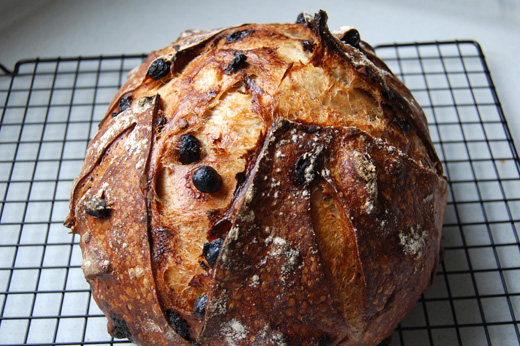
How Old Is Your Starter?
I’ve heard of starters that are so many years old, I’m sure you have too..you know…the story of the 50 year old starter.
Often it’s said with some significance of the age as if it has a magic quality about it. I think the magic part of it is the fact you’ve managed to remember to feed it for so long, since it does for the most part sit there quietly not screaming for your attention….that’s how I remember to feed the kids.
Well, the story of ‘my starter is 50 years old’ reminds me of the programme Only Fools And Horses where the character Trigger talks how he’s had his broom for 20 years, and proceeds to explain how it’s had 17 new heads and 14 new handles over those years.
The math of how much of the original starter is still there after a few feeds became clear to me when I made my own starter using Dan’s recipe which uses yoghurt. I wanted to work out how many feeds I would have to do before it was safe to use for allergy kid and with some help it worked out after only 6 feeds of it I would have 0.03% of the original starter in it. Now you can do the math for 50 years.
Somewhere in one of Debra’s answer she mentions it takes 2 weeks of the right temperature for the Lactobacillus sanfranciscensis to establish itself in your happy pool kept at room temperature…not long then.

I’m hoping this has helped you as much as it has helped and confirmed some of what I already knew. Thank you Advanced Bread & Pastry, Harold McGee and most of all thank you wonderful Debra Wink for making my brain stretch and enlighten my sourdough journey.
All of this information is fantastic knowledge and will help understand where things go wrong, but it won’t be a replacement for getting your hands sticky with dough and feeling it because that’s ultimately the conversation one needs to have with our sourdough.
